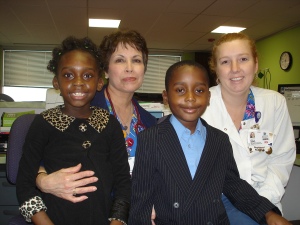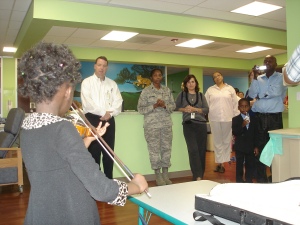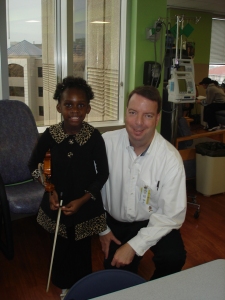This month, Carol Mulumba celebrated her first full year free from sickle cell anemia. Now 8 years old, Carol had a bone marrow transplant at Methodist Children’s Hospital one year ago. Bone marrow donated by one of her brothers replaced Carol’s bone marrow and is now producing normal red blood cells.

Carol Mulumba (left) thanks RNs Gloria Muniz and Star Ross for caring for her after her bone marrow transplant a year ago. Her 6-year-old brother Mark, second from the right, donated his bone marrow to help cure his sister of sickle cell anemia.
To thank Dr. Michael Grimley and the staff, Carol and her family paid a surprise visit this week with healthy fruit baskets and a violin performance from Carol, who is now free of the painful symptoms of the disease.
“Carol is living because of the work of Dr. Michael Grimley and the staff at the hospital,” said Lukiah Mulumba, Carol’s mother. Carol was experiencing severe pain that required hospitalization. Treatment options included continued pain management through blood transfusions, which in many sickle cell patients can lead to iron overload and long-term health implications including shorter life expectancy.
Sickle cell anemia is an inherited blood disorder that causes pain, organ damage and early death. Of the approximately 80,000 individuals with sickle cell anemia in the United States, most are of African descent. Carol’s parents are both from Uganda. Persons with the disease have abnormal hemoglobin in their red blood cells. The hemoglobin molecules cluster together after releasing oxygen, causing the red blood cells to become rigid and curved like a sickle.

Carol plays the violin for, from left to right, Dr. Michael Grimley, mother Lukiah Mulumba, Dr. Veronica Jude, Transplant Coordinator Denise Lim, brother Mark and father Abudallah Mulumba.
The sickle-shaped cells get trapped in the blood stream and can no longer deliver oxygen to organs and tissues. Some are destroyed by the liver or spleen. The body is unable to produce new red blood cells rapidly enough to replace the trapped or destroyed cells. As a result, organs and tissues do not receive sufficient oxygen. Frequent episodes of pain are the most common symptoms of sickle cell anemia, usually in the stomach, arms, legs, hands or feet. Feeling tired and difficulty fighting infections also are among the common symptoms.
You can learn more about sickle cells at the Web site of the National Heart Lung and Blood Institute at http://www.nhlbi.nih.gov
Carol was diagnosed with sickle cell disease when she was only 3-years-old . It progressed as she grew older and she was in constant pain and at risk of having a stroke.
The Children’s Cancer and Blood Center of the Methodist Children’s Hospital is among the busiest pediatric blood and marrow stem cell transplant programs in the U.S.
— SA Health

What a breath taking story! We need such stories for the sickle cell community. Thank you for sharing. London, England.
Thanks to Dr. Michael Grimley and the staff; I subscribe to Captain Lukiah’s partnent statement that “Carol is living because of the work of Dr. Michael Grimley and the staff”.
My sinere thanks should go to Mark who donated the bone marrow to Carol, RNs Gloria Muniz and Star Ross who cared for her after the BMT, Mummy and Daddy for your support and to Carol’s classmates and teachers for the love and care.